Related Research Articles

Drawing is a visual art that uses an instrument to mark paper or another two-dimensional surface. The instrument might be pencils, crayons, pens with inks, brushes with paints, or combinations of these, and in more modern times, computer styluses with graphics tablets.

A pastel is an art medium in a variety of forms including a stick, a square, a pebble, or a pan of color, though other forms are possible; they consist of powdered pigment and a binder. The pigments used in pastels are similar to those used to produce some other colored visual arts media, such as oil paints; the binder is of a neutral hue and low saturation. The color effect of pastels is closer to the natural dry pigments than that of any other process. Pastels have been used by artists since the Renaissance, and gained considerable popularity in the 18th century, when a number of notable artists made pastel their primary medium.

Jean-Auguste-Dominique Ingres was a French Neoclassical painter. Ingres was profoundly influenced by past artistic traditions and aspired to become the guardian of academic orthodoxy against the ascendant Romantic style. Although he considered himself a painter of history in the tradition of Nicolas Poussin and Jacques-Louis David, it is his portraits, both painted and drawn, that are recognized as his greatest legacy. His expressive distortions of form and space made him an important precursor of modern art, influencing Picasso, Matisse and other modernists.

A figure drawing is a drawing of the human form in any of its various shapes and postures, using any of the drawing media. The term can also refer to the act of producing such a drawing. The degree of representation may range from highly detailed, anatomically correct renderings to loose and expressive sketches. A life drawing is a drawing of the human figure, traditionally nude, from observation of a live model. Creating life drawings, or life studies, in a life class, has been a large element in the traditional training of artists in the Western world since the Renaissance.
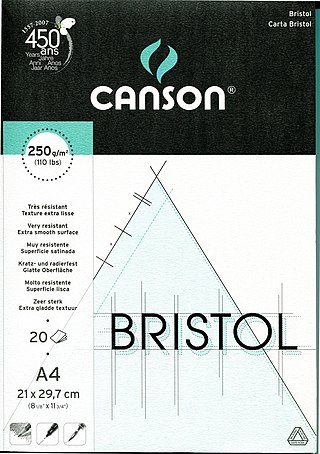
Bristol board is an uncoated, machine-finished paperboard. It is not named after the city of Bristol in the southwest of England but rather after Frederick Hervey, 4th Earl of Bristol, a prolific art collector. Common sizes include 22+1⁄2 in × 28+1⁄2 in and its bulk thickness is 0.006 inches (0.15 mm) or higher and A4, A3, A2 and A1. Bristol board may be rated by the number of plies it contains, basis weight, or, in Europe, by its grammage of 220 to 250 g/m2. It is normally white, but is also made in different colours.
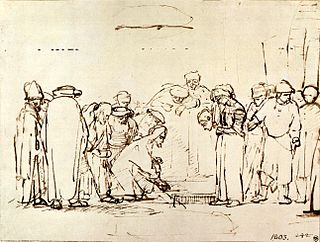
A sketch is a rapidly executed freehand drawing that is not usually intended as a finished work. A sketch may serve a number of purposes: it might record something that the artist sees, it might record or develop an idea for later use or it might be used as a quick way of graphically demonstrating an image, idea or principle. Sketching is the most inexpensive art medium.

Anne-François-Louis Janmot was a French painter and poet.

Wove paper is a type of paper first created centuries ago in the Orient, and subsequently introduced to England, Europe and the American colonies in the mid-eighteenth century. Hand-made wove paper was first produced by using a wooden mould that contained a finely-woven brass vellum, upon which the paper pulp was applied and dried, creating a smooth, uniform surface.
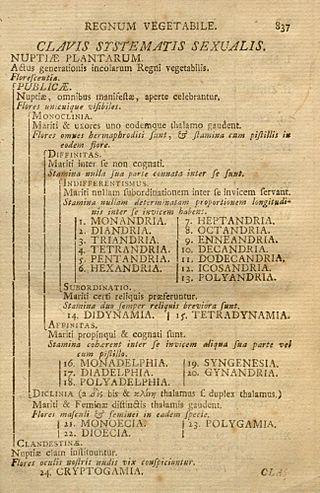
Laid paper is a type of paper having a ribbed texture imparted by the manufacturing process. In the pre-mechanical period of European papermaking, laid paper was the predominant kind of paper produced. Its use, however, diminished in the 19th century, when it was largely supplanted by wove paper. Laid paper is still commonly used by artists as a support for charcoal drawings.
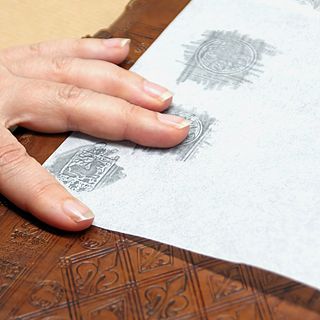
A rubbing (frottage) is a reproduction of the texture of a surface created by placing a piece of paper or similar material over the subject and then rubbing the paper with something to deposit marks, most commonly charcoal or pencil but also various forms of blotted and rolled ink, chalk, wax, and many other substances. For all its simplicity, the technique can be used to produce blur-free images of minuscule elevations and depressions on areas of any size in a way that can hardly be matched by even the most elaborate, state-of-the-art methods. In this way, surface elevations measuring only a few thousandths of a millimeter can be made visible.
Canson is a French manufacturer of fine art paper and related products. The company, established in 1557 by the Montgolfier family, produces papers for different uses in fine art, including watercolor, oil, acrylic, photo papers, among others.

Napoleon I on his Imperial Throne is an 1806 portrait of Napoleon I of France in his coronation costume, painted by the French painter Jean-Auguste-Dominique Ingres.

Portrait of Monsieur Bertin is an 1832 oil on canvas painting by Jean-Auguste-Dominique Ingres. It depicts Louis-François Bertin (1766–1841), the French writer, art collector and director of the pro-royalist Journal des débats. Ingres completed the portrait during his first period of success; having achieved acclaim as a history painter, he accepted portrait commissions with reluctance, regarding them as a distraction from more important work. Bertin was a friend and a politically active member of the French upper-middle class. Ingres presents him as a personification of the commercially minded leaders of the liberal reign of Louis Philippe I. He is physically imposing and self-assured, but his real-life personality shines through – warm, wry and engaging to those who had earned his trust.

The Apotheosis of Homer is a grand 1827 painting by Jean-Auguste-Dominique Ingres, now exhibited at the Louvre as INV 5417. The symmetrical composition depicts Homer being crowned by a winged figure personifying Victory or the Universe. Forty-four additional figures pay homage to the poet in a kind of classical confession of faith.

Danja Akulin rose to prominence by creating large format pencil drawings that reinstate this genre's autonomous value.
The following outline is provided as an overview of and typical guide to drawing and drawings:

A colored pencil, coloured pencil, map pencil, pencil crayon, or coloured/colouring lead is an art medium constructed of a narrow, pigmented core encased in a wooden cylindrical case. Unlike graphite and charcoal pencils, colored pencils' cores are wax- or oil-based and contain varying proportions of pigments, additives, and binding agents. Water-soluble (watercolor) pencils and pastel pencils are also manufactured as well as colored cores for mechanical pencils.

Artists' charcoal is charcoal used as a dry art medium. Both compressed charcoal and charcoal sticks are used. The marks it leaves behind on paper are much less permanent that with other media such as graphite, and so lines can easily be erased and blended. Charcoal can produce lines that are very light or intensely black. The dry medium can be applied to almost any surface from smooth to very coarse. Fixatives are used with charcoal drawings to solidify the position to prevent erasing or rubbing off of charcoal dusts.
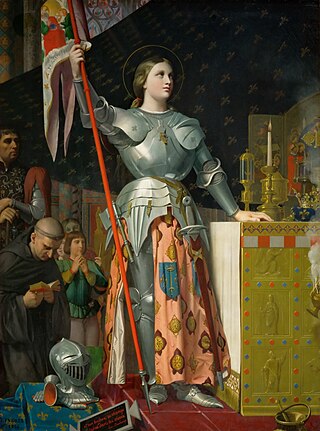
Joan of Arc at the Coronation of Charles VII is an 1854 painting by Jean-Auguste-Dominique Ingres. It is now in the Louvre Museum in Paris.
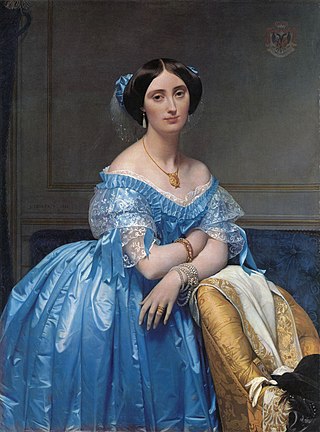
The Princesse de Broglie is an oil-on-canvas painting by the French Neoclassical artist Jean-Auguste-Dominique Ingres. It was painted between 1851 and 1853, and shows Pauline de Broglie, who adopted the courtesy title 'Princesse'. Born Pauline de Galard de Brassac de Béarn, she married Albert de Broglie, the future 28th Prime Minister of France, in 1845. Pauline was 28 at the time of the painting's completion. She was highly intelligent and widely known for her beauty, but she suffered from profound shyness and the painting captures her melancholia. Pauline contracted tuberculosis in her early 30s and died in 1860 aged 35. Although Albert lived until 1901, he was heartbroken and did not remarry.
References
- ↑ Saitzyk, Steven (1987). Art Hardware: The Definitive Guide to Artists' Materials. New York: Watson-Guptill. ISBN 0-8230-0266-7.